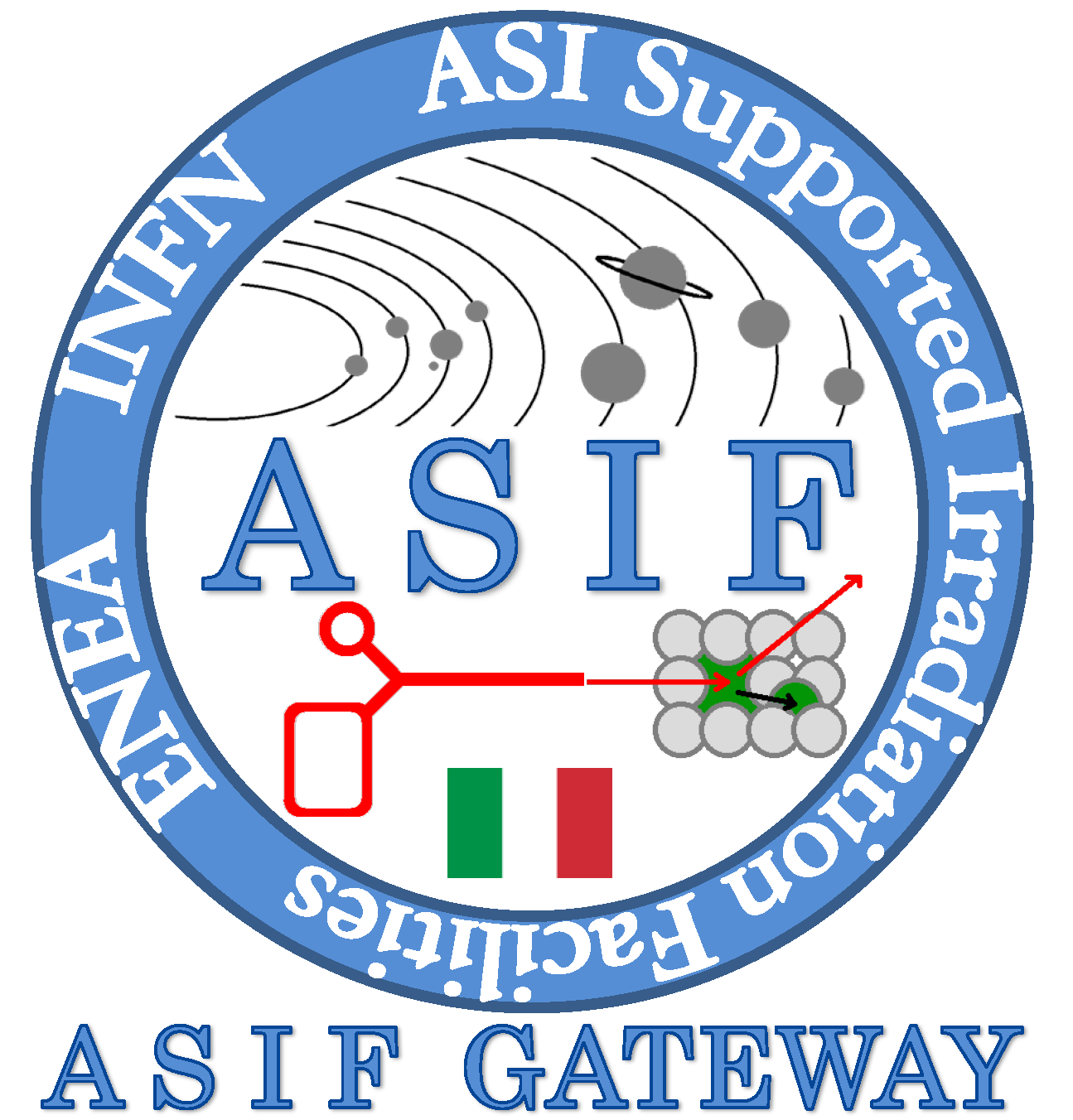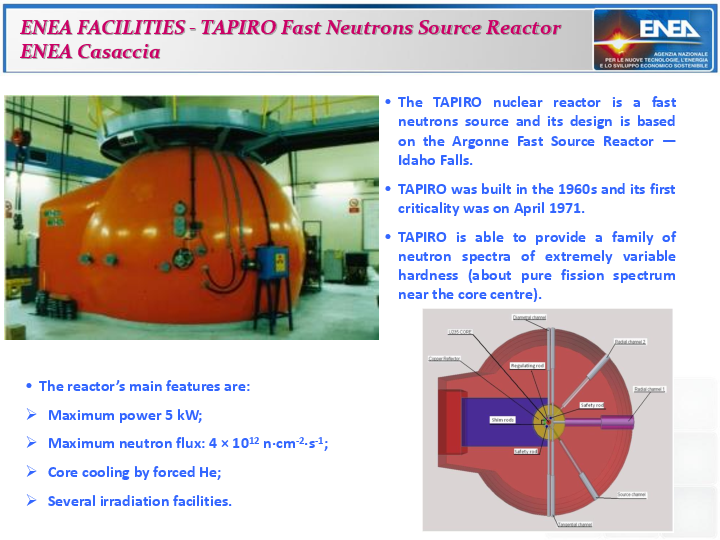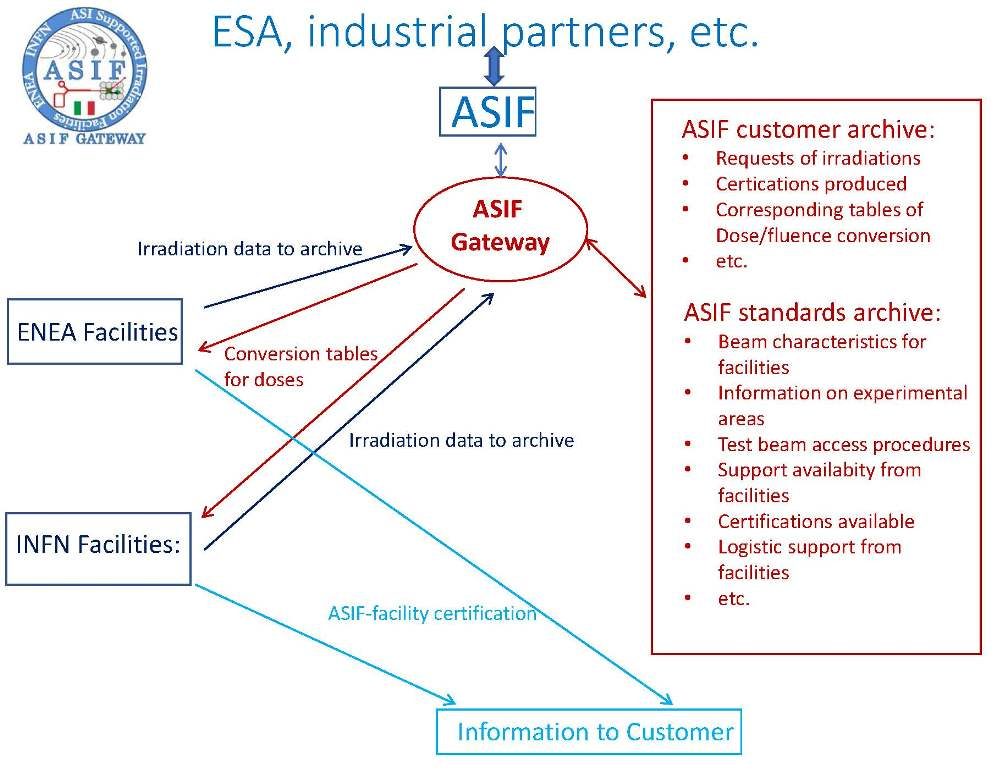ASIF GATEWAY: user access to ASIF irradiation facilities
Asi Supported Irradiation Facilities (ASIF) GATEWAY of ASI-ENEA-INFN agreements

Website latest update on January 13, 2023
In space radiation environment (similarly to other radiation environments), electronic devices undergo radiation damage induced by both cumulative and single event effects, i.e.,
- single event effects (SEE) - due to a highly ionizing dose deposition caused by a single high energy particle occurring in a sensitive region of a device - can occur at any time and with short time response;
- total ionizing dose (TID) effects - due to the accumulation of ionizing dose deposition over a long time - are a long term effects and uniformly affect all devices;
- displacement damage (TNID) effects – due to the accumulation of crystal lattice defects over a long time – are long term effects and uniformly affect all devices
ASIF program, as formulated by ASI (see this webpage), aims to establish an interactive coordinated set of the irradiation facilities, throughout the national territory, serving the national and international space communities. In fact, at national level industrial and institutional/research assets and centers in the field of EEE need to be coordinated, supported and represented at international level.
Italy has a long experience in the field of electronics devices design, manufacturing and utilization for various market sectors and in particular for Space. For instance, in the last years some project have been implemented in the field of GaAs/GaN EEE for consolidating the presence of the National GaN supply chain in the european context, thus achieving the role of second european source.
In the above context, the core elements of the supply chain are the availability of dedicated infrastructures like foundries, design centers, testing facilities and research centers and, finally, irradiation facilities.
Furthermore, it is worth to remark that the knowledge of space radiation environment, in general, is a driving element for:
- focusing the investigation of radiation damage,
- developing treatment/transport/simulation tools, and modelling particle fluxes and their transport to predict the expected operating conditions in space ratiation environment,
- evaluating radiation impact on devices and their qualification, in view of their operation in space for both orbital and deep space missions.
The ASIF gateway website provides comprehensive technical information about the different facilities, conditions of use, availability and a beam time booking tool, following Sect. 3.3 in ESA-TECQEC-RP-1376.
Users can find a general description of ASIF aims and activities at the asif website and here. Users should register in order to request irradiation time and/or related pieces of information.
In the present website, the registered users will have available pieces of information on:
- Introduction to each facility
- Particle species and beam parameters
- Energies or spectral distribution available.
- Flux information.
- Dosimetry information (dose, dose rate) or flux information.
- Energy measurement accuracy information.
- Flux measurement accuracy
- Radiation field uniformity at sample.
- Beam purity.
- Beam set-up and calibration procedure information.
- Detailed description of the procedures required to book facility beam time (standard facility access procedure).
For studies exploiting reactor neutrons (i.e., TRIGA and TAPIRO facilities available in ASIF), at the booking procedure for irradiation time, registered users can obtain the expected NIEL doses using the appropriate reactor spectral fluence by mean of sr-niel dedicated calculators based on NJOY code.
ASIF agreements with ENEA and INFN were established based on the consolidated concept that the development of future generation of EEE components is or is expected to be a key strategic area of interest for future Investments.
Currently, the ASIF gateway is located in the ASIF support center at the Physics Department of Milano-Bicocca University and it is supported within the ASIF implementation agreement involving ASI and Milano-Bicocca University. In addition (see ASIF implementation agreements 2017-22-HD.0 ASI-ENEA, 2017-15-HD.0 ASI-INFN, 2021-39-HH.0 ASI-ENEA and ASIF implementation agreement 2021-36-HH.0 involving ASI and Milano-Bicocca University), sr-niel, helmod and geomagsphere websites are supported within the space radiation environment activities of ASIF framework; their websevers are located in ASIF support center.


